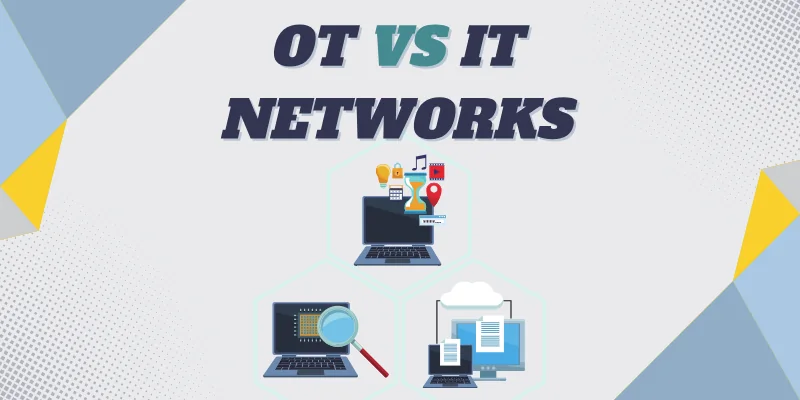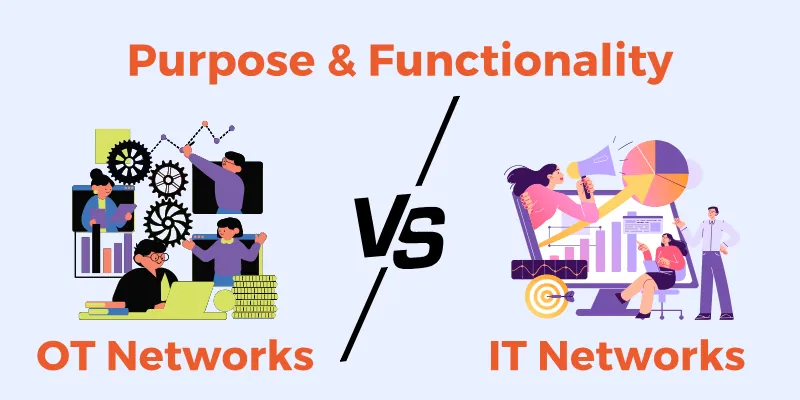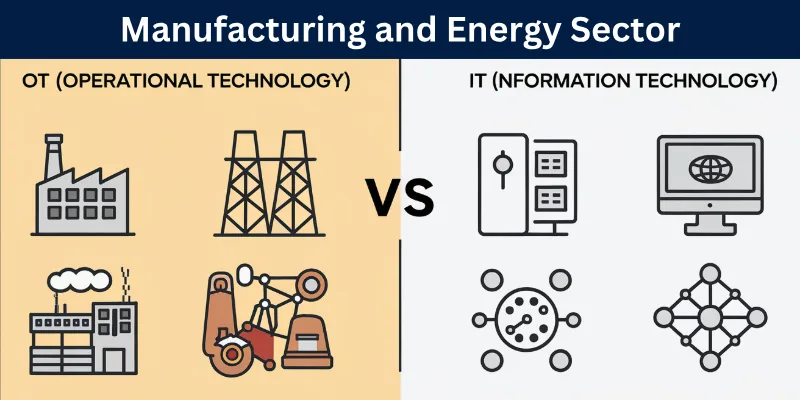Key Comparison Between OT and IT Networks: Detailed Guide
Published: 3 Jan 2025
Operational Technology (OT) and Information Technology (IT) networks are two distinct pillars that drive modern industries. While OT networks manage physical processes and industrial equipment, IT networks focus on data processing and communication.

With the rise of Industry 4.0 and smart technologies, understanding the differences between these networks has become essential. From their unique functions and protocols to their distinct security requirements, OT and IT networks serve critical but separate roles in businesses worldwide.
This guide explores the key differences, convergence trends, and how industries are adapting to these evolving technologies.
Quick Comparison Table: OT vs IT Networks
Here’s a quick comparison table of OT vs IT Networks:
| Aspect | OT Networks | IT Networks |
| Purpose | Manage physical processes and industrial operations | Handle data processing and communication |
| Focus | Operational reliability and real-time control | Data security and scalability |
| Environment | Harsh industrial settings | Controlled office or virtual environments |
| Lifespan | Long system life cycles | Frequent upgrades and short life cycles |
| Protocols | Specialized industrial protocols (e.g., Modbus) | Standard IT protocols (e.g., TCP/IP, HTTP) |
| Security Priority | Operational safety and equipment integrity | Data protection and privacy |
| Performance | Low latency and high reliability | High bandwidth and throughput |
| Examples of Use | Smart factories, power grids | Cloud computing, corporate networks |
| Integration Challenge | Cybersecurity and interoperability | Collaboration with OT environments |
| Primary Industries | Manufacturing, energy, healthcare | Business, finance, and information systems |
Core Differences Between OT and IT Networks
Operational Technology (OT) and Information Technology (IT) networks are foundational to modern industries, yet they differ significantly in their design, purpose, and operation. Below, we explore the core distinctions that set these two types of networks apart:
1. Purpose and Functionality
OT Networks: Primarily focused on controlling physical processes and industrial equipment. Their main goal is to ensure the reliable operation of machinery in real-time environments. Examples include monitoring factory production lines, managing power grids, and operating transportation systems.

IT Networks: Designed for data storage, processing, and communication. Their primary aim is to optimize information flow and support business operations, such as email systems, databases, and cloud computing.
2. Real-Time Requirements
OT Networks: Operate with strict real-time constraints to maintain physical system stability and efficiency. A delay in OT can result in operational failures, safety hazards, or production halts.
IT Networks: While some IT applications benefit from low latency, many focus on data accuracy and integrity over real-time responsiveness.
3. Communication Protocols
OT Networks: Use specialized industrial protocols like Modbus, Profibus, and OPC UA. These are tailored for reliable communication in harsh environments.
IT Networks: Employ standard protocols such as HTTP, FTP, and TCP/IP, which are designed for general-purpose data transfer and interoperability.
4. Security Priorities
OT Networks: Security is often focused on operational safety and preventing physical damage to equipment. Cybersecurity measures may be less advanced due to older system architectures.
IT Networks: Data protection is the top priority. IT networks employ advanced encryption, firewalls, and other measures to prevent breaches and maintain confidentiality.
5. System Life Cycles
OT Networks: Tend to have long life cycles, often lasting decades, due to the high cost and complexity of replacing industrial systems. This longevity can lead to challenges with outdated technologies.

IT Networks: Frequently updated and upgraded to stay compatible with evolving technologies, often operating on shorter life cycle timelines.
6. Environmental Conditions
OT Networks: Operate in rugged environments, such as factories, mines, and energy plants. These systems are built to withstand physical stress, temperature extremes, and vibrations.
IT Networks: Function in controlled settings like office spaces or data centers, where environmental factors are easier to manage.
7. Performance and Reliability
OT Networks: Require high reliability and minimal downtime to prevent disruptions in critical operations. Downtime in OT can have severe consequences, including financial loss or safety risks.
IT Networks: Emphasize scalability and high performance for managing large amounts of data and supporting multiple users simultaneously.
8. Security Challenges
OT Networks: Face unique challenges, such as integrating legacy systems with modern cybersecurity measures and addressing vulnerabilities in physical operations.
IT Networks: Deal with a broader range of cybersecurity threats, including phishing, malware, and data breaches.
9. Workforce and Skills
OT Networks: Managed by engineers with expertise in industrial processes and equipment. They often lack deep familiarity with IT cybersecurity.

IT Networks: Handled by IT professionals specializing in networking, data management, and cybersecurity.
By understanding these core differences, industries can better manage the integration of OT and IT networks, leveraging their strengths while addressing their unique challenges. This knowledge is critical for businesses embracing Industry 4.0 and digital transformation.
Examples of OT and IT in Action
Understanding how OT (Operational Technology) and IT (Information Technology) networks function can be made clearer through real-world examples. Below are scenarios where each type of network plays a crucial role:
- Smart Factory Automation (OT): Robotic arms, conveyor belts, and PLCs manage assembly lines with real-time precision.
- Corporate IT Operations (IT): Email systems, cloud storage, and collaboration tools streamline office workflows and communication.
- Power Grid Management (OT): SCADA systems monitor and control electricity distribution to ensure a stable power supply.
- E-Commerce Platforms (IT): IT networks handle online transactions, customer data, and website operations for seamless user experiences.
- Smart Grid Systems (OT + IT): OT devices manage physical grid infrastructure, while IT systems analyze energy consumption data for optimization.
- Public Transit Automation (OT): Automated control of trains and traffic lights ensures safety and operational efficiency.
- Banking Systems (IT): IT networks enable secure online banking, mobile transactions, and data management.
- Healthcare Technology (OT + IT): OT manages medical devices like ventilators, while IT processes electronic health records and supports telemedicine.
- Retail Automation (OT): Warehouse robots and smart shelves optimize inventory handling in real time.
- Aerospace Navigation (OT): Aircraft control systems rely on OT for safe navigation, complemented by IT systems managing mission data.
These examples highlight how OT and IT networks serve distinct purposes yet increasingly intersect in today’s interconnected world. Their collaboration is essential for achieving operational excellence and technological advancement.
Use Cases in Different Industries
OT and IT networks are applied across various industries, each leveraging their unique strengths to enhance efficiency, security, and innovation. Below are some key use cases demonstrating their roles:
Manufacturing:
- OT: Robotic arms and industrial control systems manage real-time production.
- IT: ERP systems handle supply chain management and workflow optimization.

Energy Sector:
- OT: SCADA systems monitor and control electricity grids for reliability.
- IT: Predictive analytics optimize energy distribution and billing.
Healthcare:
- OT: Devices like MRI machines and patient monitors ensure precise care.
- IT: Electronic Health Records (EHRs) manage patient data and enable telemedicine.
Transportation:
- OT: Automated traffic lights and train control systems ensure smooth operations.
- IT: Ticketing systems and fleet management software enhance service delivery.
Retail and E-Commerce:
- OT: Automated warehouses with robotic inventory systems manage stock in real time.
- IT: IT networks power e-commerce platforms, secure payments, and customer data handling.
Agriculture:
- OT: Precision farming technologies, like drones and automated irrigation, improve crop yield.
- IT: Farm management software processes sensor data for better decision-making.
Banking and Finance:
- OT: ATMs provide reliable access to cash and perform basic transactions.
- IT: Online banking systems manage secure digital transactions and data storage.
Aerospace and Defense:
- OT: Navigation systems and flight controls ensure real-time operation and safety.
- IT: IT systems handle mission planning and secure communication.
Telecommunications:
- OT: Towers and network infrastructure enable uninterrupted data transmission.
- IT: Cloud platforms and data centers support telecom services like video streaming.

Smart Cities:
- OT: IoT devices control traffic lights, waste management, and public utilities.
- IT: Data analytics platforms process sensor data for improved city planning.
These use cases showcase how OT and IT networks serve critical roles in their respective domains. While OT focuses on real-time control and operation, IT complements it by managing data, enabling integration, and driving innovation across industries.
Future Trends in OT and IT Networks
The future of OT and IT networks focuses on seamless integration, driven by IoT, AI, and enhanced cybersecurity, enabling smarter, more efficient operations, we’ll explore all them below in details.
- Increased Integration: OT and IT networks will merge further, creating unified systems for better data sharing and operational efficiency.
- IoT Expansion: The Internet of Things (IoT) will drive the adoption of connected devices, bridging the gap between OT and IT networks.
- Enhanced Cybersecurity: Advanced security measures will be developed to protect both OT and IT systems from evolving cyber threats.
- AI and Machine Learning: Predictive maintenance, anomaly detection, and process optimization will be driven by AI and ML in both OT and IT domains.
- Edge Computing: Decentralized data processing at the edge will reduce latency and enhance real-time decision-making for OT systems.
- 5G Connectivity: Faster and more reliable 5G networks will enable seamless communication between OT and IT systems.
- Digital Twins: Virtual replicas of physical assets will improve monitoring, simulation, and predictive analytics across OT and IT.
- Sustainability Initiatives: Green technologies and energy-efficient solutions will shape the design and operation of OT and IT networks.
- Autonomous Operations: Self-regulating systems will reduce the need for human intervention in both OT and IT environments.
- Standardization and Interoperability: Unified standards will simplify the integration of diverse technologies and protocols in OT and IT networks.
How to Integrate OT and IT Networks Successfully
Successfully integrating OT and IT networks requires strategic planning, interoperable technologies, and robust security measures. let’s discuss them in details.

- Assess Current Systems: Conduct a thorough audit of existing OT and IT infrastructure to identify integration opportunities and challenges.
- Establish Clear Objectives: Define integration goals, such as improving efficiency, enhancing security, or enabling real-time data sharing.
- Adopt Interoperable Technologies: Use hardware and software that support common protocols and standards for seamless communication.
- Enhance Cybersecurity: Implement robust security measures, such as firewalls, encryption, and regular vulnerability assessments, to protect both networks.
- Leverage IoT and Edge Computing: Use IoT devices and edge computing solutions to connect OT devices with IT systems for faster decision-making.
- Invest in Training: Educate employees on the benefits and challenges of integration to ensure proper use and management of the combined networks.
- Use Middleware Solutions: Employ middleware to facilitate data exchange and compatibility between OT and IT systems.
- Implement Scalable Solutions: Choose scalable technologies that can grow with your organization’s needs and future advancements.
- Collaborate Across Teams: Foster collaboration between OT engineers and IT professionals to ensure smooth integration.
- Monitor and Optimize: Continuously monitor integrated systems for performance and make adjustments to address inefficiencies or emerging issues.
Key Benefits of OT and IT Integration
Here we discuss the key benefits of OT and IT Integration below:
- Improved Efficiency: Combining OT’s real-time control with IT’s data analysis optimizes processes and reduces downtime.
- Enhanced Decision-Making: Integrated systems provide actionable insights by analyzing operational and business data together.
- Cost Savings: Automation and streamlined workflows lower operational costs and minimize resource waste.
- Better Predictive Maintenance: IT analytics can predict equipment failures in OT systems, reducing unexpected downtime.
- Increased Flexibility: Integrated systems adapt quickly to changing market demands and operational requirements.
- Enhanced Security: Unified cybersecurity strategies protect both OT and IT networks from emerging threats.
- Seamless Data Sharing: Real-time data flow between OT and IT enables better collaboration across departments.
- Scalability: Integrated systems support growth and technological advancements without significant overhauls.
- Innovation Opportunities: Collaboration between OT and IT fosters innovation in smart factories, smart grids, and other sectors.
- Customer Satisfaction: Improved processes and insights lead to better products, services, and customer experiences.
Challenges and Risks of Integration
Let’s talk about all the challenges and risks of integration in detail below:

- Cybersecurity Vulnerabilities: Merging OT and IT networks increases the attack surface for cyber threats.
- Compatibility Issues: Legacy OT systems may not easily integrate with modern IT infrastructure, causing delays and added costs.
- Data Silos: Inconsistent data formats or lack of communication between systems can hinder seamless integration.
- Cultural Differences: OT and IT teams often have distinct workflows and priorities, creating collaboration challenges.
- High Initial Costs: Implementing integration solutions, including new hardware and software, requires significant investment.
- Downtime Risks: Transitioning to integrated systems can cause temporary disruptions to operations.
- Complexity of Management: Managing an integrated system requires specialized skills and tools, increasing operational complexity.
- Scalability Limitations: Not all integration solutions can scale effectively with growing operational needs.
- Regulatory Compliance: Ensuring compliance with industry standards and regulations across both OT and IT systems can be challenging.
- Lack of Expertise: A shortage of professionals skilled in both OT and IT domains can delay successful integration.
Conclusion
In summary, OT and IT networks are indispensable components of modern technology ecosystems, each designed to serve specific purposes. OT networks prioritize operational control and real-time reliability, while IT networks emphasize data management and scalability. As industries embrace digital transformation, the convergence of OT and IT networks offers immense potential for efficiency and innovation.
However, this integration also presents challenges, such as cybersecurity risks and compatibility issues. By understanding the unique characteristics and benefits of each network, organizations can make informed decisions to leverage their strengths for future growth.
FAQs on OT and IT Networks
Here are some of the most Frequently Asked Questions related to OT and IT Networks:
OT (Operational Technology) networks control physical devices and processes, while IT (Information Technology) networks manage data, communication, and digital systems.
Integration enhances efficiency, improves decision-making, and enables real-time data sharing, leading to optimized operations and cost savings.
Industries like manufacturing, energy, healthcare, transportation, and retail see significant benefits from streamlined operations and improved analytics.
Ensuring cybersecurity’s while maintaining compatibility between legacy OT systems and modern IT infrastructure is a major challenge.
Integrated networks are more vulnerable to cyber threats, requiring robust security measures like firewalls, encryption, and regular monitoring.
Yes, but it often requires middleware or system upgrades to bridge compatibility gaps and enable smooth communication.
IoT connects physical OT devices with IT networks, enabling real-time monitoring, data collection, and advanced analytics.
By combining real-time control with advanced data processing, integration reduces downtime, automated workflows, and enhances productivity.
Risks include cyber threats, downtime during implementation, high initial costs, and challenges in managing integrated systems.
The future includes increased integration, enhanced AI and IoT usage, stronger cybersecurity measures, and a shift toward smarter, automated systems.

- Be Respectful
- Stay Relevant
- Stay Positive
- True Feedback
- Encourage Discussion
- Avoid Spamming
- No Fake News
- Don't Copy-Paste
- No Personal Attacks

- Be Respectful
- Stay Relevant
- Stay Positive
- True Feedback
- Encourage Discussion
- Avoid Spamming
- No Fake News
- Don't Copy-Paste
- No Personal Attacks





